11 th Dragon Regiment
"King Carol II Romanian" in Bratislava
 From October 16, 1936 Lieutenant cavalry Aladár Ondrejkovič performed a voluntary service at the 11th Dragon Regiment in Bratislava. In the 1936 he was made a state visit at the head of the Romanian Kingdom of the Czechoslovak Republic. On that occasion, His Majesty King Carol II of Romania November 1, 1936 at Freedom Square in Bratislava cast their standard to 11th Dragoon Regiment. Since then he was called Dragoon Regiment King Carol II of Romania. Some officers, including Lieutenant Aladár Ondrejkovič received from His Majesty for equestrian combat bravura demonstration of the Romanian military decoration.
From October 16, 1936 Lieutenant cavalry Aladár Ondrejkovič performed a voluntary service at the 11th Dragon Regiment in Bratislava. In the 1936 he was made a state visit at the head of the Romanian Kingdom of the Czechoslovak Republic. On that occasion, His Majesty King Carol II of Romania November 1, 1936 at Freedom Square in Bratislava cast their standard to 11th Dragoon Regiment. Since then he was called Dragoon Regiment King Carol II of Romania. Some officers, including Lieutenant Aladár Ondrejkovič received from His Majesty for equestrian combat bravura demonstration of the Romanian military decoration.

Carol II of Romania
and Czechoslovak president Dr. Eduard Beneš with their governments on the occasion of the state visit of the head of the Romanian kingdom again declared an alliance of both countries, members of the Little Entente. It was a reaction to the reduction of the League of Nations in Geneva and retreat of the French Republic of the great powers positions in Central Europe and in the Balkans.

Lieutenant cavalry Aladár Ondrejkovič Liber Baro Sandor of Slavnicza, the Military Steeplechase winner took part in the 11th Dragons Regiment with King Carol II of Romania, Crown Prince Michal I and President Eduard Beneš at Freedom Square as squad Commander.

Royal Guard of His Majesty Carol II. Romanian rode at the head of the solemn military parade 11th Dragon Regiment on 1 November 1936 at the Freedom Square in Bratislava.

King Carol II of Romania and Prince Mihai I of Romania during the inspection units of the Czechoslovak army. 11th Dragon Regiment was organizationally assigned to the 3rd Cavalry Brigade, which was part of the newly created task force of higher Cs. Army, the German counterpart Panzerdivision, elite Rapid Division No.3. VII Corps, Army III. Squadron regiment barracks and stables were present on Kutuzov street in Bratislava and in cities Sereď, Zvolen and the Levice. In Bratislava, the use of training facilities covered riding directly in the barracks of M. M. Hodža and Kuchajda, where there were areas with facilities for show-jumping over obstacles (jumping). Major of infantery Jozef Martin Kristín 30.09.1936-DD.MM.1939 2. inteligence section, VII. corps.
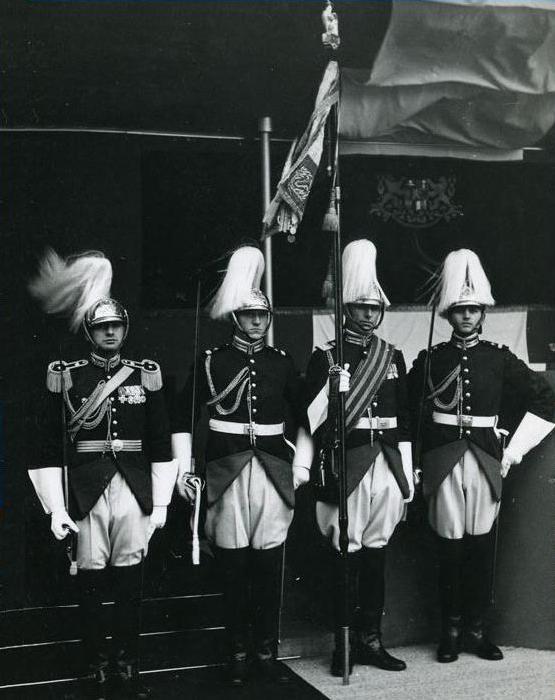
Romanian Royal Guard at the state visit of King Carol II of Romania and Crown Prince Mihai I of Romania in Prague at a ceremony.
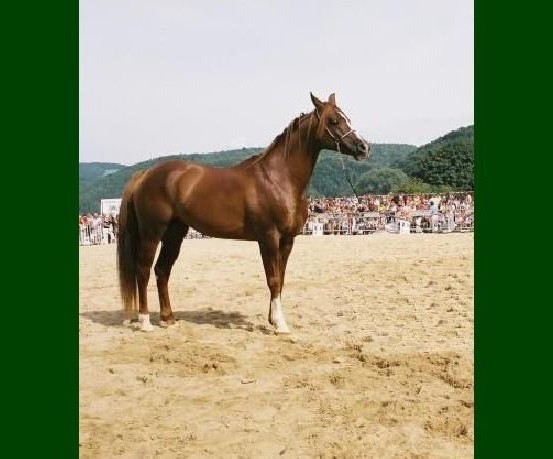
Remont largely answerable for the regiment then Lieutenant cavalry Aladár II Ondrejkovics-Sandor in the military stud in Motešice, who headed ing. Antonín Lokvenc, whose daughter was actress Magda Lokvencová - Husáková (an excellent horsewoman herself) and son in law was Dr. Gustav Husák, the future president of Czechoslovakia. Before he became a communist and later a major factor in SNP. How cold the rights of the former Catholic college Svoradov. He worked in academic association "Lawyer". Ján Mikula was the Vice President, Social Democrat Anton Rašla later Attorney General and the National Social Court Administrator, Secretary Gustav Husák and Jozef Kirschbaum librarian.
The original owner of stud and lock the Motešice was genus Motesiczky, multiple marriages linked to gender Sandor de Szlavnicza and Ondrejkovics together of neighbors and social relations. Descendants of the family live today in Bratislava. The author reported that at present they were still prevented any access to the castle.

From 1933 and 1935 entered into force aggressive organizational measures. They increase the role Čs. army fighting capacity. The government increased its staffing level by extending the military presence of basic services for two years by adopting a larger number of reserve officers, warrant officers and noncommissioned officers in active service and another to the state professionals. Continue to not address the problematic ethnic composition of the corps commander Čs.army forces higher power in proportion to the ethnic composition of the team. Probably had an impact on soldiers and their relationship to the Czechoslovak Army, but it was certainly irresponsible to ensure the continued existence of the state. in recent years of the Republic. The focus of the State Government strategic moves abnormally to the east, including the control centers. Keeping up when the state realized that they would not be able to function effectively without the involvement of local people engaged. In the army were from Slovakia only 1 general and 3 Lieutenant colonels. Rare was the for example Major artilery Alojz Androvič the official involvement of the 2nd Department headquarters in Prague. His grandfather, Alexander de Androvich (Androvics) was a major retrieve Púchov in around 1865, after his retirement he was a judge in Trenčín and here remain publicly advocated Slovak political interests. Convened reservists for up to several weeks in the exercise. The team had to be total overkill, motorization and modernization of the Army and Air Force. On the financial backing has been released extrabudgetary resources for example 30% devaluation of the currency. In 1937, military spending 37% of the state budget in 1938 54% of the state budget. State-fold increase in investment in infrastructure and military industries in Slovakia. Ordered by the private firms. For example, all production slog SpA Škoda Plzeň is rapidly moved to Slovakia.


Since 1935, held each year at least large maneuvers at the church. In practice, reviewing the interaction of organizational units and senior officers the ability to apply the new practice field order Czechoslovak Army, for example Rapid division transfer over long distances and, immediately after combat deployment. For example, a complete regiment of cavalry squadron trains exported to eastern Slovakia, and then they moved on horseback through the entire national territory to an area of concentration. Squadron was moved off the main road and spent the night shift during the course of the randomly selected rural villages in the school building.
Royal visit in Bratislava.
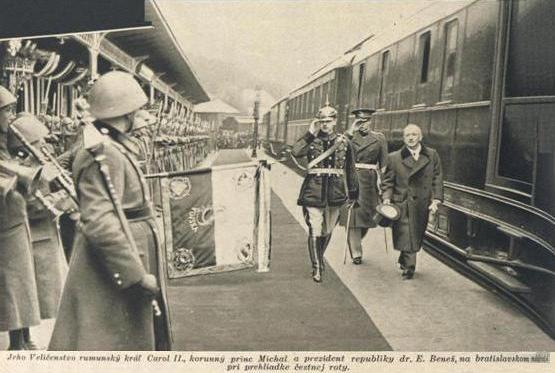
His Majesty the Romanian King Carol II, Crown Prince Michael I and president dr. E. Benes, the Bratislava station during a tour honest company.
On November 1, 1936 was a holiday, albeit rainy. City welcomed King Carol II, Prince Michael I and the members of the delegation. In the morning mist blew the Romanian tricolor. The newspaper "Slovak newspaper" articles published with illustrations and an editorial on the visit by Teodor Emandi, the Romanian ambassador in Prague called "King of Romania in Bratislava 's passage:
"On November 1, His Majesty Carol II. Romanian arrived in Bratislava. The importance of the visit is special and every citizen of Romania should not forget that in addition to the Danube Bratislava port washes the Romanian border. It combines political, economic and cultural Bratislava and the two friendly countries and citizens all ages. Danube often flowed more blood than water and nothing do not associate people over shared suffering. He had no doubt say that when times normalized Bratislava, which has made progress becomes a port on the Danube, which is the cradle of the Romanians. Visit of His Majesty affirmed the importance of the port Bratislava and around the ruins of the sacred Devina built in times of great pain of those who were unjustly enslaved, the wind will odtaľto to valley of the beautiful Danube joy echo the voice of the people, that there was a great king, with big ideas of peace, tranquility and order. "
The newspaper published the article Jinřiška Húsková-Flajšhansová, Romanian is a lecturer at the Comenius University in Bratislava. In an article entitled "King Carol II - Prince culture" enumerates all our deeds Sovereign Romanian cultural prosperity, since the first initiatives of Prince Carol II. and cultural foundation for the various complexities of today's royal foundations. Majesty affect knowledge as one of the few leaders of the nations, in addition to the efforts of the general prosperity of the nation's efforts to strengthen its intellectual wealth.
Romanian lecturer at the University of Bratislava, dr. Jindra Hušková Flajšhansová pay-Romanian King 7 clusters of their works on cultural and political relations Czechoslovakia-Romania.
German newspaper "Grenzbote" devoted contents event. Called "a day of great visit" published an editorial containing the biography of the monarch. "King Carol II. - He writes - is one of the most energetic and the most popular of State in every sense of the word and" King revealed that his heart beats for ethnic minorities in his country. "The newspaper also published an extensive report on the visit and a portrait of King Carol II. In addition, King Carol got the editor Portisch of German write the history of the city, bound in leather safián. The slovak magazine" New World "published a special issue dedicated to the dynasty and our country.

Big parade on Freedom Square in Bratislava. Lieutenant cavalry Aladár II Ondrejkovič attended a festive tour of the 11th Dragon Regiment by the Romanian King Carol II with the President of the Republic, Eduard Beneš, at Nám. Slobody Square as squad Commander.

King Carol II of Romania personally in Freedom Square 1 November 1936 ribbon pinned on the flag 11th Dragoons Regiment. Tasteful gift is 11th Dragoons Regiment to His Majesty that since November 1, bears the name of King Carol II. Romanian. It's a great album of all officers of the regiment, attached to the silver plates on which the Romanian and Czechoslovak flag.

Grandstand view of the defilired army. The means king, right next to him, his son, the crown prince Mihai I. His Majesty King Carol II made tentative reservations about the regimental dragons' riding boots. Source: Lt. colonel Aladár II Ondrejkovič year 1995.
Romanian King Carol gave for staying in Prague 50 000 Kč poor and for the poor 10,000 Kč in Brno and Bratislava. It is customary to give a precious and beloved by giving gifts, according to the old proverb secure friendship. Our automotive industry in Europe is in last place and it is natural that the royal guests were given demonstrations of our automobile production. The president gave the Romanian King special passenger car Skoda brand with unbreakable glass and Fr. Ringhofer, Chairman plants Tatra 12 large cylindrical Tatras. Zbrojovka Brno donated to Prince Michal latest car, four-cylinder two-stroke Z-5 and ground Slovak motorboat. King Carol II. Slovak gave ground in memory of the visit of Slovakia box silver with Golden State and Erb in her gold coins Czechoslovakia. excavation. Grand Duke Michael Land Committee received from a riding whip with a gold handle and noble city of Bratislava paid hosts three publications about the city, magnificently bound, his silver medal, stieborné plates, old travel clocks, leather-wrapped box in her photos and prominent city buildings.
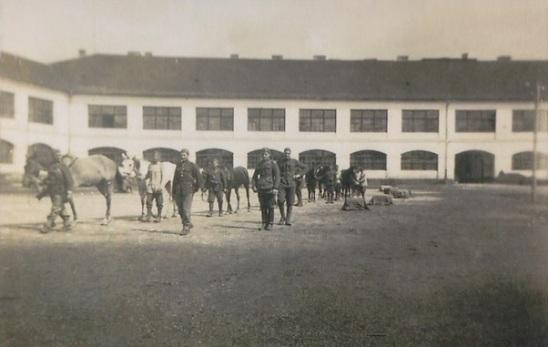
14th Train Squadron of Spišská Nová Ves, barracks of M. R. Štefánik. In the Spišská Nová Ves was the Public Notary Dr. Ladislav Štefánik, a friend of the Ondrejkovic family, whom lieutenant cavalry Aladár II Ondrejkovič used to be in the service of this town.

In 1937 the Trebatice stayed over night at school, which was over the teacher Stephanus Ondrejkovics (Stefan II. Ondrejkovič) Squadron of 11th Dragon Regiment, Squadron commanded Lieutenant cavalry Aladár II. Ondrejkovics-Sandor de Slavnicza, son of the administrator-teacher's Stefan II. Ondrejkovič. Squadron welcomed by the whole community and people behave to them as to his own son.
General Hans Piekenbrock * 1893 Essen † 1959 Essen. Chief I. Department Abwehr Major 1936-1943, 1937 Lieutenant Colonel, Colonel 1940, 1943 General. Coverage of major interest to Czechoslovakia, Poland, France, UK, USSR, Spain. Side interests against Belgium, Switzerland, Yugoslavia, Romania, United States. Prohibited activity against Austria, Italy, Hungary, Finland, Estonia, Japan, Bulgaria. Munich branch of the Abwehr worked against the Balkans, Czechoslovakia, Switzerland. CSR also worked against a branch in Dresden, Breslau, Konigsberg, later in Vienna and Nuremberg. Violent peace agents - foreigners, local Germans, soldiers arrived. nationality, border residents.
V roku 1938 používal úrad čs. voj. pridelenca plk. gšt. Antonína Hrona aj kuriérne spojenie rumunského voj. attaché v Berlíne. Rumunský voj. attaché pplk. Petre Antonescu ponúkol v prípade nutnosti aj ochranu jeho vyslanectva aj od jeho ochranou odjazd do Rumunska cez Poľsko v kritickej dobe 1938. Správy dôležité pre Rumunsko, ktoré dostával od úradu čs. voj. pridelenca vedel oceniť a dobre sa odmeňoval správami cennými pre Československú republiku. Vždy boli presné. Zdroj: Milan Vyhlídal - Matej Medvecký. Vojenská história 4, 22, 2018 str. 146.

During the mobilization in 1938 was the 11th Dragoon Regiment deployed to defend the territory of Slovakia. Under the command Lt. cavalry Aladár II. Ondrejkovics-Sandor de Szalvnicza at night the squadron swim riding across the river Hron and took up battle position on the borders. Úloha brániť Slovensko a Podkarpatskú Rus proti útoku maďarskej, resp. poľskej armády pripadla 3. československej armáde, ktorej velil generál J. Votruba a neskôr generál Lev Prchala. Tretia armáda mala 89 228 vojakov a 3 161 dôstojníkov. Dôstojníkov-Slovákov bolo 217. Vojaci aj na Slovensku a Podkarpatskej Rusi obsadili pripravené pozície a pohraničné opevnenia a očakávali rozkazy.
Kingdom of Romania was the only ally of Czechoslovak Republic determined to meet its contractual obligations to Czechoslovakia. Support to Cs. Republic demonstrated the broadest layers of the Romanian society, especially party Agrarians (Carano) and leftist parties.

Division General Vasile Atanasiu in September 1938, publicly declared that it makes available to the Czechoslovak government. The Kingdom of Romania's commitments to Czechoslovakia took a clear position and commander of its military intelligence service in the years 1924-1940 Mihail Moruzov - Secret de Serviciului informatio al României (Siguranta).

Lieutenant cavalry Aladár II. Ondrejkovič de had a commanding position in the village Mužľa in the school building. Staff of Rapid Division No. 3. had a fear of deployment of its forces in the south of Slovakia in an Hungarian minority. Concern, at least in the near Mužla confirmed. Squadron commander knew spotlessly Hungarian. The local population even though its not know personally knew the family you come from, behave to him very willingly and with the deepest respect. His dragons had no problems, but on the contrary it happened that a soldier deliberately fired on the other side. However, it has avoided without consequences.

After the signing of the Munich Agreement in 1938 30.september Lieutenant cavalry Aladár II. Ondrejkovič with his squadron and elite armed forces of the Czechoslovak State Battalion SOS 28th /Nové Zámky/Nitra (political districts: Stará Ďala, Hlohovec, Komárno, Zlaté Moravce, Nitra, Parkáň, Piešťany, Sala, Vráble, Nové Zámky. Status battalion SOS: 1012 men, ie 184 country policeman, 48 police officers, 227 members of the financial guard, 553 men of the troop surge) was ordered to assume a defensive position at the village Tesárske Mlyňany. They belonged to the scope of the District Chief of the Zlaté Moravce Dr. Aladár I. Ondrejkovič, who participated in drawing up the Battalion SOS 28th Nové Zámky/Nitra (brother of his father, administrator teacher Stefan II. Ondrejkovič).
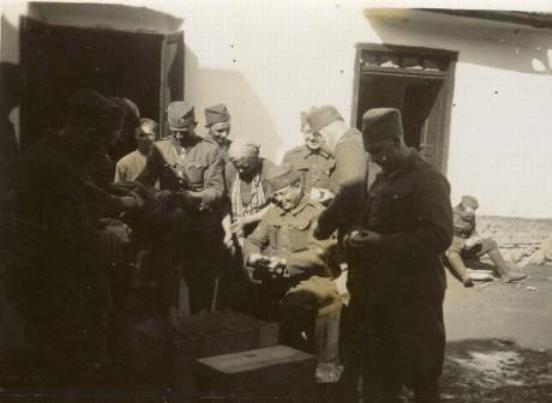
Command post of Lieutenant cavalry Aladár II. Ondrejkovič were in the Arboretum Mlyňany, property-related him consanguineous families. The château was accommodated by their officer of a soldier, they had the field kitchen.

The President of the Czech - Slovak Republic commissioned His Honor the Chief Justice Dr. Martin Mičura (relative family Ondrejkovič) agreement is concluded on 02.18.1939 between the Czecho-Slovak Republic and Hungarian Kingdom on Issues of citizenship resulting from the connection area apportion Hungary arbitral award in Vienna 2 november 1938. The president signed it in Prague 02.27.1939. Member of the Delimitation Commission in the transmission area of southern Slovakia, Hungary was Major Josef Turanec, who objected to Lt. Aladár Ondrejkovič that allowed the wives and daughters of Czech officers and professional soldiers to abstain in Mlyňany. Arboretum and Mlynany mansion belonged to the family (Ludmilla Ambrózy) Lieutenant Ondrejkovič. After the Vienna Award had also Lt.cav. Aladár II. Ondrejkovič its position in order to pass the Hungarian army. Hungarian soldiers came to the Arboretum from a great distance , very tired after walking small groups without any transport vehicles. The last was brought to the carriage captain Honvéd Tomba, whom the lieutenant of cavalry Aladár II. Ondrejkovits-Sandor de Slavnica officially handed 10 November 1938 the person entrusted with the defense department Mlyňany.
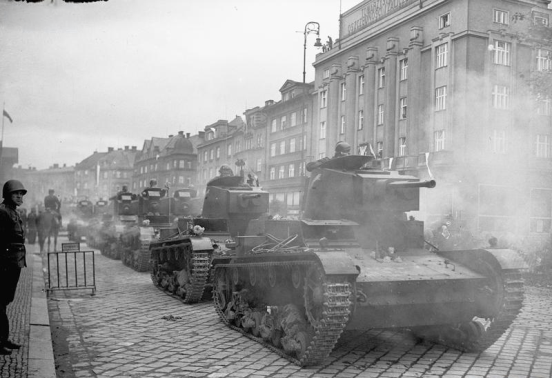
After the Munich agreement the Polish tanks 7 TP occupy Czech Cieszyn in the 1.October 1938. In the 27 November Polish 10th cavalry brigade ocuppy Slovak Javorina the desperate resistance of the local population.

District chief Dr. Aladár I. Ondrejkovič was subsequently Land Office in Bratislava promptly folded from Zlaté Moravce to Prešov there with the task to solve a crisis situation as regards the forced resignation of Kosice, South Slovakia and the southern part Ruthenia, for Hungary, on the basis of the first Vienna Arbitration on 2 November 1938. The State came December 1 in favor of Poland and of the territory covering an area of 226 km2 in the north of Slovakia.

Light tanks Skoda Lt 35, armored cars Tatra OA Mk 30, truck Walter PN, Tatra T 28 and Praga RV, evacuation czechoslovak barracks of Košice. In Kosice was District Chief Stephen II Balažovič, his office was evacuated to Prešov. There was his office incorporated into the office here from Zlate Moravce fold, the Provincial Office in Bratislava entrusted with specific tasks in Prešov District Chief Dr. Aladar I Ondrejkovič, his relative after Maria Ondrejkovič born Turba. In Prešov District Chief Dr. Aladár I Ondrejkovič Freiherr Sandor de Szlavnicza was forced to confront the armed terrorist bands who penetrated into the district of Poland and parts of the territory occupied Hungary.
Hlási sa Prešov ! Zdroj: noviny "Slovenský hlas" z 18. novembra 1938 str. 4. Evakuácia Košíc pretrhala spoje so slovenským východom. Nový okresný náčelník Dr. Aladár Ondrejkovič prevzal úrad.
_____k__pia_____k__pia_____obr6o.200710_133432_23.jpg)
Young dragon officers short jackeds very liked, but the regimental commander obey them not like to wear, because they inherited the K.u.K cavalry. Probably because they hated the Colonel cav. Rudolf Moskorz to them because of his age and character could not afford to wear.

Regiment commander 11 "KC II R" in 1939, were:
Lt. Col GS. from March 1936, Col. GS. Josef Vrzáček (January 1936 - September 1936)
Lt. Col. cav. Gustav Viktorin (September 1936 - September 1937)
Colonel cav. Rudolf Moskorz (September 1937 - March 1939)
Thu. Capt. cav. Ján Veselý (March 1939 -)...
Officers of Dragon Regiment 11 "KC II R"
Staff Captain of cavalry Ján Veselý regiment commander (later Colonel Ján Veselý commander 2.Technicle division in the Italy in 1945), 2 Cpt. cav. Ivan Fajnor 1th reg. Adjutant, 3 Cpt. cav. Štefan Bella commander 2 squadron, 4 Cpt. cav Ján Izák commander 5th squadron, 5 First Lt. cav. Peter Vlčko commander 3th squadron, 6 Lt. cav. Ján Straka commander 7th squadron, Lt. cav. Imrich Sádovský commander 4th squadron, 8 T. no. that time in the field, Lt. cav. Jan Tamas commander of remont squadron Šalgočka - Dvorníky, 9 Lt. cav. Ondrej Červenák Elected 10th squadron, 10 Lt. Stefan del Feja commander of squadron 14th Spišská Nová Ves, 11 Lt. cav. Aladár Ondrejkovič commander 18th squadron.
Staff Sergeants of Dragon Regiment 11 "KC II R"
First Warant cav. Ferdinand Tyrš RTM. warehouseman 10th squadron. Elected. Second Battalion. horseshoes. František Veleba Horseshoe rem. squadron Šalgočka - third Dvorníky steep. clothing. Vincent Beňo HS. 4th RTM. driving. Ondrej Chyniranyi accounts. serg. esc. 5th rtm. cavalry Ján Šmída accounts. 2 esc. 6th rtm. cavalry František Barčák accounts. 5 esc. 7th rtm. Pavel Melíšek armor armorer 8th Regiment rtm. horseshoes. 8th rtm. Horseshoe

Continue serving of Dragon Regiment 11 "KC II R"
First sergant in pr. serv. Ján Masiarčin Number. the spare. kor. Second sergant in pr. serv. Marek Trpíška in HS. Third sergant d. serv. Stefan Kašovský serv. rtm. 1 esc. Type No. in section 4 serg.d. serv. Béla Imrich výk. RTM. 2 esk. 5th serg. d.sl. Stefan Galovič size. platoon t.č. sixth in field serg. d.sl. Ján Birch výk. First serg. 3 esk. 7th serg. d.sl. Clement Anton Lesser Horseshoe 3 esk. Type No. eighth in a field serg. d.sl. Kiss Ernest výk. RTM. 4th esk. 9th serg. d.sl. Josef Švarek size. Platoon 2 esk. 10th serg. d.sl. Ján Vasko výk. First serg. rem esk. 11th Cat. d.sl. Paško Anton billed. RTM. i. 11 esk. 12th Cat. d.sl. Tutko Michal com. Platoon 1 esk. 13th serg. d. sl. Michal Novotny size. kul. platoon t.č. in box 14 Cat. d.sl. Matthew Karol Horseshoe 5 esk. Type No. hospital in 15th Cat. d.sl. Michal Hudec remont rider 16th Cat. d.sl. Simon Marčan remont rider 17th serg.d.sl. Michal Horvath commander platoon 18th serg.d.sl. Magdin Emil billed. 18 esk. 19th Cat. d.sl. Josef Ross in pom. Esk. Car 20th serg.d.serv. Kičina Josef serv. 14 esc. Type No. that time in the hospital.
The status of the Little Entente countries were weakened for ethnic disagreements in Yugoslavia and the activation of Nazi intelligence. In addition, the increase in commodity exchange between Germany and Yugoslavia was in double digits year on year. For example whitegardist col. Duron living in Belgrade, Abwehr agent, former Wrangel officer, was representative of several German companies in Yugoslavia (npr. iron Stollbeg the Rhine). Should contact the Ministry of Defence of the host country. Maintain a connection through the German embassy in Belgrade. After the occupation of Yugoslavia in 1941, was assigned to Division III Abwehr as a trustee. Mgr. Werner Markert * 03.02.1905, Sonderfuhrer, directed by April 1942, OKW Abwehr 2. Abt. ION paper (Abwehr control commandos on the Eastern Front). Then took the other function in 2.oddelení and focused its activities against Poland and Yugoslavia). Prof. Puzzled Dr.Jozef captain professionally OKW Abwehr in occupied Belgrade.
Before 1939 Commander Yugoslav military intelligence, General Petar Zivkovic (* 1879 † 1953) informed its allies of internal political pressure to change the political orientation of Yugoslavia, presadzovali ju regent princ Pavle Karadjodje a predseda vlády Milan Stojadinovič.
In early March 1939, held a brief visit of King Carol II of Romania in Czechoslovakia to exchange most secret intelligence information with the opinion of the General Staff of the Romanian Army. It was also in progress to accelerate the arms supplies to Romania.
The headquarters of Deutsche Partei (DP) was in Bratislava in the building Kotva the Vajanský waterfront. Its armed forces Freiwillige Schutzstaffel (FS) formed in March 1939, three battalions, which had 4604 men. Weapons that received mainly through Petržalka distributed them in the building anchors. On 11 March 1939 FS 50 men occupied the government building on the waterfront. V marci 1938 boli na Slovensku dislokované tri čs. armádne zbory so siedmimi divíziami.

On 14 March Czechoslovak Army defeated the uprising of Ukrainian nationalists in Chust. Coordinated by the Berlin headquarters of the Abwehr with the declaration of the Slovak state that day. Hungarian troops in the morning March 15, 1939 began occupation of Ruthenia in coordination with the occupation of Bohemia, Moravia and Slezia Wehrmacht also the morning that day. Part of 12 Infantry Division commander General Josef Svátek they resisted. The Romanian government immediately responded Little Entente commitments, observing it in the early hours of the Hungarian attack ordered partial mobilization. Yet that day troops boarded the Hungarian border, where the Kingdom of Romania had previously concentrated 40,000 soldiers.


Colonel GST. František Moravec and colleagues of Major infantry Alojz Androvič of 2 Division HQ Czechoslovak army to drift into the UK by airplane of company KLM Douglas DC-2 across Germany on 15.03.1939. Major infantry Alojz Androvič was tasked to Slovakia. Left : St. Captain Jaroslav Tauer, St. Capt. Ladislav Cigna, Major Josef Bartík, Colonel GST František Moravec and Major Emil Strankmüller who later commanded the 1st Report offensive department, whose responsibilities included the Special Group D - responsible for training skydivers.
_____k__pia_____pic_02_01.301211_013542_23.jpg)
Soldiers Infantry Regiment 45 ,,Romania" (SV Chust of Commander Lt. colonel Infantry František Václavek) in the rear-guard battle with Ukrainian separatists and Hungarian troops were withdrawn in March 1939 with members of SOS, state police and financial officers to Romania, covering the evacuation of civilians and President Ruthenia Augustin Voloshin, weapons and military equipment submitted the Romanian army with 14 armored vehicles. Recent soldiers existent state Bečkov defender retreated to Romania on 21 March 1939. Infantry regiment 36 (SV Svaljava, Perechyn) and gym troops had withdrawn after the fighting retreat Slovakia with SOS units (women, young children and elders retreated SOS in the snow drifts over the mountains into Perečin has impeded infantry regiment 36). Perečin for over contested corridor trains evacuated thousands of civilians in Slovakia, struggles to hit a section of 2. speh toop together 3rd regiment of tanks attacking. chariots and withdrew into Humenné 18 March 1939 newly formed Slovak army took to the former state, Čs. officers and soldiers even after the event Ruthenian Ukrainian descent who were competent to Ruthenia if so requested (mjr. cav. Jaroslav Kmicikievič, First lieutenant cav. Juraj Bílej, lieutenant air. Mikuláš Guljanič etc.).
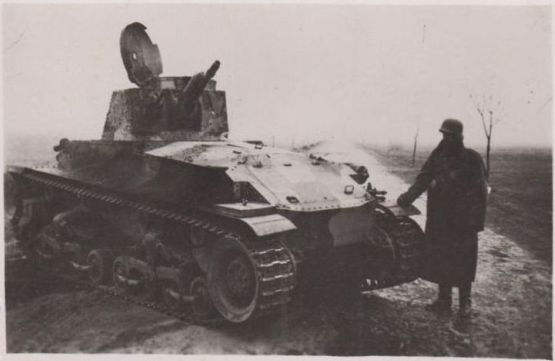
Damaged tank Škoda Lt 35. Fighting participated with him fitters manufacturer were to accompany their destination in railway transport through Ruthenia.
After March 14, 1939 he was District Chief Dr. Aladár II Ondrejkovič to greater work and organizational burden when the District Prešov found himself in a war zone in the context of fighting troops (and their evacuation with the authorities and civil parties) now-defunct Czechoslovak state in Ruthenia the Hungarian army, which already occurred on March 22 the territory of Slovakia.
In contrast, commander of the Hungarian military intelligence General István Ujszászy (* 1894 † 1948) was in a better position.
Junior and senior officers had a Slovak army on 15 July 1939 with 704 (of which 536 Slovaks, Czechs 117, 27 Germans and 24 Russians and Ruthenians). Od 29. augusta 1939 bolo zakázané cestovať so slovenským cestovným pasom do zahraničia bez povolenia ministerstva vnútra, čo súviselo so zhoršenou mezinárodnou situáciou pred vojenským napadnutím Poľska. (22).
Bernolák Command, (1939)
(29 August 1939 - 24 September 1939).
Commander Slovakian Field Army "Bernolák" - gen. I. cl. Ferdinand Čatloš

Chief of Staff - Major GS. Emil Novotný
Second chief Staff - Major GS. Karol Peknik
Chief of a department. Staff - Major GS. William Kanák
Chief of Section 2. Staff - Major artillery Alojz Androvič
Chief of Section 3. Staff - Major GS. Koloman Brezány
Chief of Section 4. Staff - Major GS. Alojz Ballay
Artillery Commander - Lt. Col. GS. Rudolf Pilfousek
Commander of Air Force - Major works. Raymond Šmarda (v.r.)
Commander UHS - Capt. years. Pavlišta
Commander of engineer troops - Major pion. Stefan Pohranc
Commander tel. Army - Major tel. Ján Morvic
Chief výzbrojní serv. - Capt. SPR. armor. Max. Rudolf Proksch
Chief medical. serv. - Capt. healthy. Dr Paul Frost
Chief vet. serv. - Major vet. MVDr. Mikuláš Ferjenčík
Chief SCD - Major works. Vladimir Schmidt
Chief intend. - Major Int. Vojtech Bauman
Chief of the spirit. serv. - Lt. spirit. Valentin Vilkovský
commander's headquarters - cf. bummer. in z. Matthias Roth
Head office - cf. Boar. František Pokorný
Commander tel. bat. - Capt. tel. Josef Marko
Chief of the half. numerous. - Major Alojz Sonderlich

Since the thirties of the twentieth century was launched widespread motorization Czechoslovak Army after 15 March 1939. Slovak army went in it. Nevertheless, the army relied on thousands of horses. Horses have been an indispensable aid for the army of which had to be taken care of in the event of illness or injury. The removal of the wounded or sick horses into the veterinary hospital served "automobiles veterinary kits" that took up arms and Slovak army.
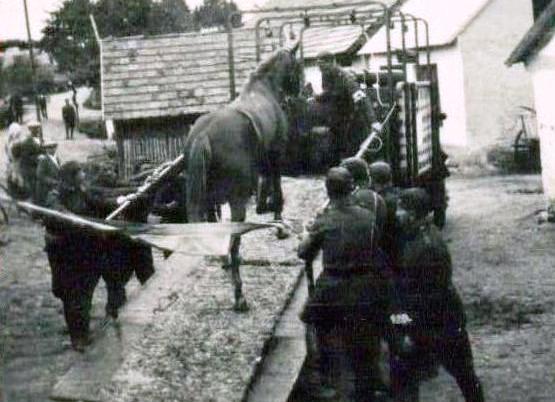
Automobile assembly of Veterinary servise Mk.38

Eugen Cristescu 03.04.1895 *com. Grozest, Judetul Bacau †14.06.1950, Vacaresti, commander of the Romanian Intelligence Service (SSI Special Serviciului de informatio Romaniei well) in the period 12 November 1940-23.august the 1944th Since October 1944 he was imprisoned. General Antonescu dictatorship raised in Romania 04.09.1940. Against Romania, he was a German Abwehr - Abteilung III F3 Abt.II an OS Abt.I / M Ost-Sud, Abt.I Luft / AO, Abt.I / P / Ost. A secret OKW in Bucharest was Major. gen. st. v. v. Urluzianu. Maintain a connection with him through the German Legation in Bucharest prostredníctvom head office Blucher. Although the major Urluzianu retired, worked at the Romanian Ministry of Defence. Reports supplied by the organization of the Romanian army and a start against Hungary, in the event of war between Romania and Hungary.
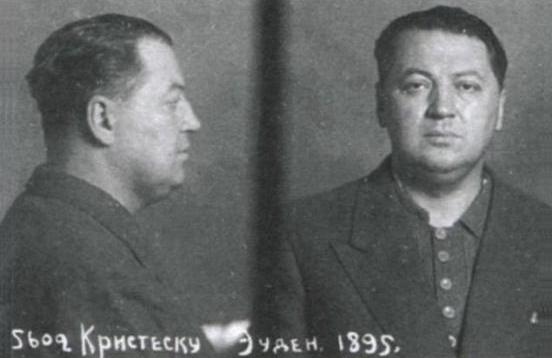
Directul SSI Eugen Cristescu
Mihail Moruzov his predecessor was executed in prison 27 November 1940 after the abdication of Jilava King Carol II and took power in Romania on 04.09.1940 General Antonescu ions.
Colonel Emil Just was OKW Abwehr I. Deputy Chief of the colonel. Hans Pieckenbrock. In 1941 he was military attaché in Romania.
After 1939, Lt. colonel artillery Alojz Androvič took office at the Slovak military ataché embassy in Budapest. From there he was transferred to military functions at the Slovak embassy ataché in Berlin.
On May 16, 1939, was cosulted committes of intelligence experts. German military commission DMK led by Lt-Gen. Franz Berckhausen, For the Slovak side she attended o.i. minister General Ferdinand Čatloš a second head Division Chief Military headquarters mjr. inf. Alojz Androvič. 22 June 1939 he was appointed special envoy in the Hungary of Slovak republik Dr. Ján Spišiak. Secretary of the Legation Dr. Jozef Omiliak. 1. oct. 1939 took office in Budapest Military ataché Major infatery Alojz Androvič. Here, as reladed by family Ondrejkovič with gender Sandor de Szlavnicza came to the attention of prominent families. In March 1940 he contacted a ralative of the family Sandor de Szlavnicza A. Andreánszky, an employee of the Military Geographical Institute and documents offered for anti-aircraft defense of Budapest and the northern border with bands of free flights Hungarian pilots in armed conflict and border fortifications plans. The documents requested pengő 5000. As a military ataché in Berlin Lt. Colonel infantery Alojz Androvič 4 May 1941, the Eastern Railway Station (Keleti pályaudvar) in Budapest waiting for words. Ambassador (Spišiak out in remembrance of Budapest 1939-44, when the asked. Lt. Colonel infantery Alojz Androvič to inform your traveling ataché Soviet military in Berlin Major General Vasily Tupikov Wehrmacht on the preparations for the upcoming attack against the Soviet Union).
Explanation: development. ataché Berlin General Tupikov from 29.06.1941 Chief of Staff 9/20/1941 South-west front fell while attempting to escape from the encirclement of Kiev u together with the Head queue Gen. Mikhail Kirponos. Lt. colonel Alojz Androvič was related families Ondrejkovič from two sides ; Lt. Colonel Androvič and general Tupikov traveled by train together in a separate carriage for examination of Greek theater with a stop in Budapest.

The Sanok. Left General Augustin Malár commander of Lieutenant cavalry Aladár II. Ondrejkovič. Augustin Malár was the then commander Lieutenant cav. of reserve Aladár II Ondrejkovič (Commander PAK) on the eastern front in Rapid division in the year 1941. He recommended him to study at the Military Academy of Automotive and direction for a career officer. To the length of study he was counted a duty on the front. In the middle of Defense Minister General Ferdinand Čatloš. Some tasks entrusted Issues in. Lt. Aladar II Ondrejkovič in 1939 and in 1943-1944 directly bypassing the commander personally. Military career was the one son of each generation in the family Ondrejkovič unwritten obligation.

After a training day went Lieutenant cavalry Aladár II Ondrejkovič and young officers at the pool floating next pioner baracs of M. M. Hodža on the Danube embankment propellers. Sometimes swim up to the Lido swimmingpool in the Petržalka, which at that time, belonged to the German Reich. The German guards but let them leave the water and therefore float right back.

Cavalry lieutenant Pavel Štefánik, active officer, brilliant rider. He was not only a rival in the military cavalry lieutenant res. Aladár Ondrejkovič, but also his friend. To reassignment cavalry lieutenant res. Aladár Ondrejkovič to the automobile troops served both in the 1st equestrian section (JPO-1). Commander of the technical squadron from JPO-1, First lieutenant cavalry Pavel Štefánik, son of a public notary in Spišská Nová Ves Dr. Ladislav Štefánik and nephew of General Milan Rastislav Štefánik inherited the aristocratic coat of arms of Prokopovič, who acquired it from Emperor Leopold II. The author would like to thank his father, Dear Mrs. Tamara Dudašová, the daughter of the Major cavalry at. in. Pavel Štefánik.
The newspaper "Slovak" from August 9, 1940. The equestrian events in Bratislava. On 10 August 1940 at 8.00 pm. dressage test for the military indoor riding school in equestrian barracks. 0 9.30. Start officers and sereants the provincial riding. (Please note the 4 km long race track with obstacles natural and engineered by the riders overcome alone on military training ground "Kuchajda".) Horse patrols. On August 11, 1940 at 15.00 hrs. On the racetrack in the equestrian jumping barracks parcour officers, warrant officers and ratings. Program: 1. Return Militar officers in full armor dirt. 2. Skip military sergeants and DSL. noncommissioned officers in full armor dirt. 3. Phone book jumping "S" officers. 4, skipping Phone book "L" warrant and DSL. Sergeants 5. Return to the support team horses. After the race prize distribution at the track. Refreshments throughout the race is taken care of.
On 16 11th 1940 Congress was appointing Slovak Equestrian Federation (SJZ) in the club rooms, cafes Museum of the Danube River in Bratislava. Riding a race, however, held only sporadically, and members of the club focused on walking field trips, organizing trips Hubert. One of the biggest held in November 1942 to Kuchajda involving military and civilian riders. Show Jumping won the race as usual Lieutenant cav. Aladár Ondrejkovič. In equestrian competitions, however, was very welcome because it would take first place on a regular basis.
_____k__pia_____k__pia_____paolus_023.30706_231702_23[1].10410_094956_23.jpg)
Surveillance officer of Regiment Lieutenant cavalry Aladár II. Ondrejkovics Sandor de Slavnicza and Captain aut Alfonz Lošonský - riding barracks of M. M. Hodža in Bratislava Tehelné pole from 1938-40. Together with them to serve their friend Lieutenant of the tanks Anton Fábry.
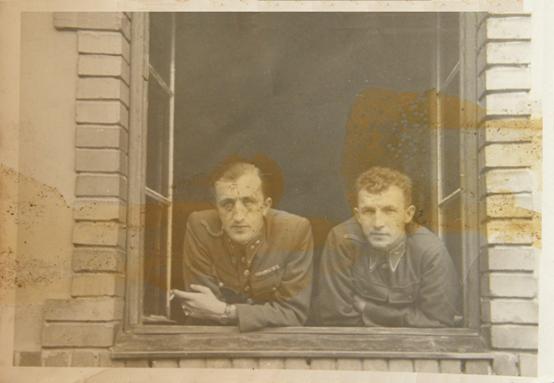
Captain automob. Alfonz Lošonský and Lieutenant of the tanks Anton Fábry in the cavalry barracs of M. M. Hodža.


Since 1944 he was in the attacking troops of the 2nd Ukrainian Front liberated by April 4, 1945 Bratislava included two Romanian army, 2nd Royal Tank Regiment and Corps Royal Air Force last Czechoslovak the Little Entente and Slovak wartime ally. Pictured assault guns Sd.Kfz 142 "StuG III" Ausf. F/8 German origin (his gun StuK 40 L/48 caliber 75 mm supplied Skoda Pilsen, branch Dubnica nad Váhom) from the 2nd Regiment Royal Romanian Army in April 1945 Bratislava, Špitálska street near the Dean's office Faculty of Medicine, 150m from the residence of Stefan Ondrejkovič and Maria Ondrejkovičová born Turba.
Tanks romanian 2nd tank battalion from major Rautu podporoval postup 409. streleckej divízie na ul. Trnavská a Šancova, okolo Hlavnej stanice a po Pražskej ul. k obci Lamač až do Devínskej Novej Vsi. Hlavné sily brigády boli v obci Ivanka pri Dunaji. Dňa 8. apríla o 16.00 hod sa sútredili v obci Marianka severovýchodne od Devínskej Novej Vsi.
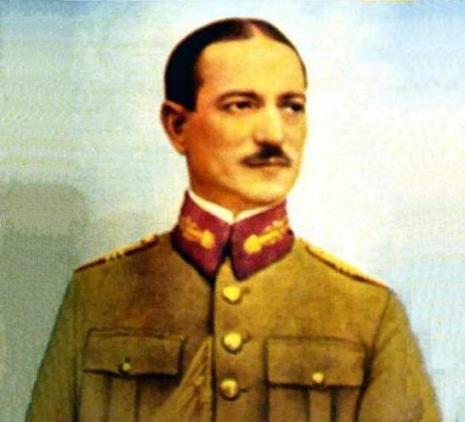
Commander of the White Lion, Romanian General Vasile Atanasiu exempts the Banská Bystrica (Slovakia) in Czechoslovakia ....He then took command of the 1st Army, taking part in the battles on the Czechoslovakian front in the Javorina, between the rivers Hron and Morava and thereafter in Bohemia.

Captain tank Aladár II Ondrejkovič Liber Baro Sandor de Szlavnicza (Lt. colonel tank Aladár II Ondrejkovič) in the year 1945.
After World War II began life in Slovakia equestrian activity hippickle military units to induce riding clubs accessible to civilians interested in equestrian sport. Continued training of police cavalry units. Training continued breeding institutes that focus on horse riding. The first civilian equestrian section in Slovakia was established in 1948 within the organization Sokol gym. In 1949 he was riding section Slovak Sokol Central Committee led by its President General JUDr. Anton Rašla. This regularly participate in equestrian competitions in the years 1940-44. Even after many years with a little envy Pavel Ondrejkovič reminded what a great rider was his father.
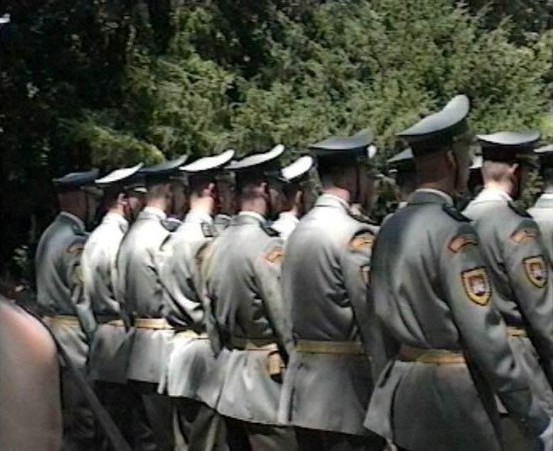
Military funeral of Lieutenant Colonel of the tanks Aladár II Ondrejkovics - Sandor de Szlavnicza.
_honorary_lieutenant_colonel_richard_cowling_cd__mrs._veronica_cowling__hrh_princess_alexandra_kg__gcvo__mrs._kathryn_kelly__mrs._bev_hughes..110413_121720_23.jpg)
Explanation: Former Military ataché USSR in Berlín General V. Tupikov from 29.06.1941 Chief of Staff of Southwest Front fell 20.09.1941 when trying to escape from encirclement at Kiev together with Commander queue Lieutenant General Mikhail Kirponos ; Lt. colonel infatery Alojz Androvič was related families Ondrejkovič from two sides ; Lt. colonel infantery Androvič and gen. Tupikov traveled by train together in a separate carriage to inspect the Greek war theater with stops in Budapest ; Josef Čermák ; Catherine Ondrejkovič born Malár * 1926 † 1992 ; Resident of SOE in Istanbul col. Alfred George Gardyne de Chastelain ; JUDr. Milan Mičura Malár Magdin 1921-1997 ; Magdaléna Fábry born Vojček 1908-1996 ; Magdaléna Mičurová born Sohlmann ; Princess Alexandra, The Honourable Lady Ogilvy LG GCVO (Alexandra Helen Elizabeth Olga Christabel; born 25 December 1936) is the youngest granddaughter of King George V and Queen Mary ; Lajos Sandor de Szlavnicza, his wife (Ambrózy N.) their sons Karóly (Carolus) Sandor de Szlavnicza 1848 sz.biró wife Ambrózy Zsofi, Lajos Sandor of Szlavnicza 1861 arvák godn. wife Mednyánszky Bora their sons István (Stephanus), Gejza, Arpád ; Replacement banner 11th Dragon Regiment was 23 January moved to Sereď ;
Sources: Slovenský denník 1st Novembre 1936 ; Slovak magazine " New World " of 1st Novembre 1936 ; Nemecký denník "Grenzbote" ; Newspaper - Národnie noviny 08.02.1941 ; General Anton Petrák ; Lady Gizelle Kerney born Ondrejkovičová ; Lt. Colonel Pavel Globan ; General JUDr. Anton Rašla ; VHA Bratislava ; Military History ; Lt. Colonel of the tanks Aladár II Ondrejkovič ; JUDr. Ján Spišiak ; Elizabeth Ondrejkovičová born Ličková ; private archives of the author ; Mária Ondrejkovičová born Turba ; Viliam Kamenický ; Royal.gov.uk- Princess Alexandra; Journal - Sattelite ; (22) VHA Bratislava, f. Vyššie veliteľstvo 1 - Veliteľstvo divíznej oblasti 1 (1939 – 1945), šk. 95, sign. 95/198/1 ; Rozkaz č. 58/1939, čl. B-427, Zákaz ciest so slovenským cest.pasom do zahraničia bez povolenia ministerstva vnútra a zavedenie vízovej povinnosti ;
♫ Štefan Hoza - Dita ; ♫ František Krištof Veselý - Saigon ; ♫ Grupul Byzantion - Fecioara Curata versuri ; Ocupation of Tešín in 1938 ; 10 Brigade of polish cavalry ocupated Javorina 27 Novembre 1938 ; Mukačevo and Užhorod 10 Novembre 1938 (Invasion) ; Mukačevo in January 1939 ;
Lovable TATRA
The second drive his father, the first private vehicle of Oberstleutnant Aladár Ondrejkovics. Always launched in the winter, only to be shot boyfriend. Gasoline (synthetic) was at that time inferior, Tatrička because here there stood still. Gas tank was under the windscreen, its status is measured ruler. Fourcylinder engine was air cooled, cooling fan at the end of the shaft, a cylinder capacity 1155 cm 3, 13.2 kW, was not more than 70-75 km / hr. It came in the driving speed, that is the motor stick. Repair was relatively simple, the father is managed well on the road itself, just had to have gloves and new rollers. Purchase Tatrička enable him brother Tibor, a clerk firma Thonet - Mundus, Vysoká 53, Živnodom.
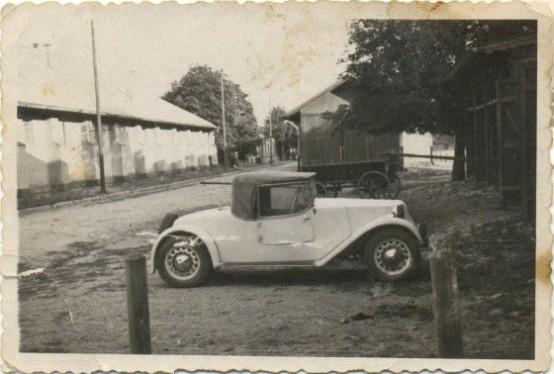
fy 5 000 crowns from its trading partners in the protectorate, which exports its products, chairs Tonett (Slovakia\'s foreign trade with the Protectorate of Bohemia and Moravia in 1941 amounted to 185 569 000 Sk) (1). The tires were in poor times, could not handle more than 5 000 km. Us kids Tatrička are very pleased, we were enthusiastic from the top was raised bonnet looked like a rhinoceros. Experienced three body convertible, small truck, Tudor type T 57 / A, rear of the reserve outside. The slide is the father of Tatra T 57 Sport cavalry barracks in the area. At the back of the car to see light military wagon Mk. 23 of train.

Praga LT-38
Just look scout equestrian JPO 1, the fifth squadron Dragon regiment, the former Dragon Regiment No 11. This type of father was the first drive. There are old photographs of their 40 long tail? - 60? under the infinite vista before them, and cottonwood veliacimi officers standing in a semi-circle maps. To have tankettes md. 33, but for their failure to run them only after Kaserne yard.
_____obr__zky_z_klu__a_usb_044.150210_233006_23.jpg)
Fitting out soldiers of the JPO 1 troop in the year 1941. The officer is seen behind the right rear of the space volume and the tank turret Praga Lt. 38.

Steyr 220 of Corps automobile park. After 1939, they bought the governments fleet of about two hundred. Lieutenant cav. Aladár Ondrejkovič received orders to choose from conscripts future instructors who will then continue to learn to drive other soldiers. The problem was when they asked which of them can drive a car ? Nobody. Who on the motorcycle ? Nobody. Who to byke ? Two. Lieutenant A.O. commanded to substantiate the two trucks wooden blocks and the first of these future instructors taught as trainers. Subsequently, he performed with ablest soldiers training ride. They then no longer under the supervision of trained other soldiers. Young drivers, military presence in the government service fleet broke about thirty cars Steyr 220 have their first runs. In ihe year 1941, in Bratislava at the Central Station of the state visit of Croatia, however, welcomed almost all government cars Steyr 220. Prominent visit then traveled fast train to Poprad and the High Tatras. Drivers Dealer Steyr 220 fleet were ordered to wait for the express in Poprad. Have not completed it famous. Half of the military drivers ended their vehicles in the ditches along the national highway in the High Tatras. The fleet also had Tatra T 87,
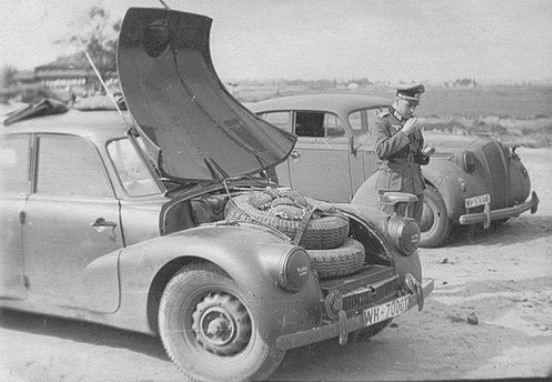
(Tatra T 87 was popular not only in Slovak officers of 1st Automobile Battalion. Wehrmacht officers literally loved it even though im OKW orders prohibiting their driving. The bad language caused casualties more officers, as partisans) Mercedes, Fiat, Lancia, Škoda.
Rarity of the car Fiat Topolino. It was perhaps the smallest, but certainly the worst corps car fleet. Despite his frequent repairs were still broken. Were not satisfied with the Lancia car. Conversely Tatra were popular. Through the war was the lack of antifreeze in the discharge of water coolers and chillers from each night were burdensome to the front and the very restrictive fighting capacity.

Ferdinand Coburg
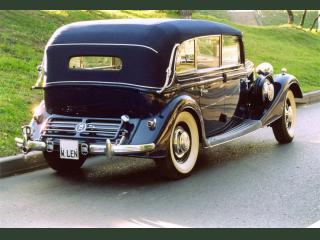
At the same kabriolet Horch 951 (A) drived too his Excellency the Bulgarian tsar father, Ferdinand Coburg - Koháry

Cabriolet Horch 951 (A) also regularly used for private purposes lieutenant František Göndör, secretary of the Bulgarian Imprerator father. Was friend of Miss Magda Ondrejkovič.
On such a car Horch 830 BL drove to the Presiden of the Supreme Court, former Minister, Comes of Tekov-Nitra, professor Komenius univerzity, landlord, Vice-Chairman of the boards of management and shareholder fy Baťa, cement factorys Ladce and Lietavská Lucka, his Excellency Dr. Martin Mičura. He was also a Member and Chairman of the Czechoslovak People\'s Party in Slovakia and the birmovný father of Aladár Ondrejkovics. Together with their brother Tibor took to the temple Vyšehrad and St. Vitus\'s car Horch opportunity for one thousand years since the death of St. Wenceslas. Both brothers received from him memorial gold medal embossed on the occasion of St. Wenceslas millennium, 28 September 1929.


For the millennium was first publicly exposed the St. Wenceslas Crown. Dr. Martin Mičura was socially very active. Friends and often meet with private T G Masaryk and his children. His friends were Janko Jesenský, colleague Dr. Imrich Karvaš, District Governor Dr. Aladár Ondrejkovič, Regional vice president Dr. Jozef Országh, Rudolf Fraštacký, Dr. Markovič etc.
Colonel gen. st. Stefan Jurech, military ataché and member of the Management Board of firm - antimony mining and metallurgical plants, a.comp. Banská Bystrica ;
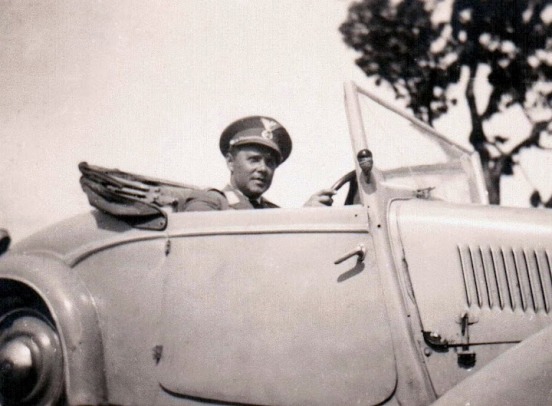
On the Slovak fighter pilot Squadron 13 and his war injury, even years after the author recalls. Nothing is forgotten. (Here the car Skoda Popular).

Tatra T27

Even bigger repairs of Tatrička T57A in the garage of the 1st Automobile Battalion have mastered the soldiers PAK of First lieutenant atomob. res. Aladár Ondrejkovič.

Officers estates ring wore a Lieutenant Colonel Aladár II Ondrejkovič

Slovak Officer\'s dagger that he wore the uniform of First lieutenant Aladár II. Ondrejkovič.

Ring the professional officers of the Air Force lieutenant family member of Lt. colonel tank Aladár II Ondrejkovič
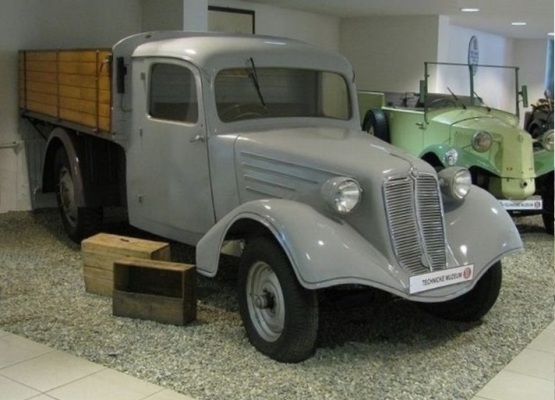
From 1944-1945 he served Tatrička T 57A kabrio for First lieutenant automob. Aladár Ondrejkovič with exchanged bodywork as a commercial vehicle.

First lieutenant Aladár Ondrejkovič was recognized in the High Tatras, his sister Magdaléna used to be at Štrbské Pleso, her husband Karol Suchánek, a well-known ice-bass athlete, worked there. He was a friend of the First lieutenant Aladár II. Ondrejkovič, before he met his wife. The Tatra community probably got used to it, after their marriage in the spring of 1944, Alžbeta\'s mother, Julia Ličková, born Stiglitz, came to the Tatras. Karol Suchánek was the last to criticize his relationship. His help to the newlyweds in the beginning were considered friends of the family Ondrejkovič District chief in Kežmarok Dr. Alex Luštek and his chief magician Public notary in Spišská Nová Ves Dr. Ladislav Štefánik from the most respected family in Slovakia for granted.

Tatranska Lomnica in 1944 during the Slovak army skiing championships in the High Tatras.

The cable car at the Lomnický shield during the slalom race in the High Tatras in 1944.

Tatrička na návšteve v Kežmarku na jar 1945.
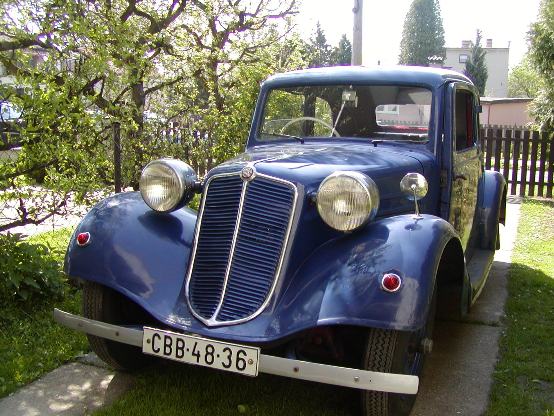
TATRA T 57/A. After year 1945 have Tatra clasic caroserie T 57/A thoose very probable, in the back have reserve and was silver color.

The Tatra T 57A car of Captain Aladár Ondrejkovič also had a proven air-cooled engine in the Quick Division. He was very easy to access and repair from every side.

Steyr 220 of Corps automobile park. Squadron leader in school for reserve officers riding in Pardubice in the year 1935 First lieutenant cavalry Julius Nosko, in picture longer than Second colonel cavalry from 1st Czechoslovak Army in Banská Bystrica in the year 1945.

Permission to ride a private motor vehicle Tatra T57A for service purposes First lieutenant Aladár Ondrejkovič on the whole of Slovakia issued January 26, 1946 the head of the automotive service 4th Military Area (VO-4) in Bratislava Major Alojz Herchl.
_____k__pia_____wm_3753046.190612_210206_23.jpg)
Their service pistol Walther (Mauser) P38k to capt car Aladár Ondrejkovič II always well hodden by a pedant from his curious small son Paul.

Tank destroyer ST-I is introduced into the arms of the renewed Cs. Army and adopted after 1945 in companies CKD Praga and Skoda Plzeň Cpt. tank Aladar Ondrejkovič II. He made his modification Marder experience already in service at the Corps automobile park Slovak Armed Forces.

School tank destroyer ST-III that led courses in which instructors for training new recruits Cs. Army Cpt. tank Aladár Ondrejkovič II was also a modification of light tanks LT 38 interceptor tanks and Marder III with whom he had experience from his service in Corps automobile park Slovak Army.

Confirmation has received captain automob. Aladár Ondrejkovič from Garrison 92 Bratislava when it took over his private motor vehicle Tatra T 57A on June 10, 1953. When this car occupied since 1989 Ministry of National Defence he replied that in that period, no vehicle Tatra T 57A Garrison 92 Bratislava administration has not taken.
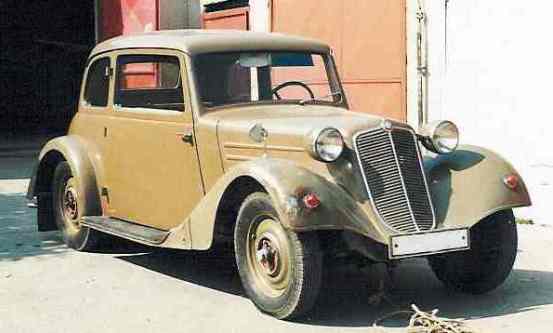
Tatrička received in the year 1945 from his owner Captain tank Aladár Ondrejkovič third body, this time a standard type Tatra 57A. Kaki Tatrička T 57A coincidence ?

A similar brick-red Škoda 1000 MB with a white roof, a varnished mask and a gray trim was the first motor vehicle to be credited with the PZO TUZEX vouchers in 1969 for its depositors, deposited with Živnobanka Prague. Citizens could buy cars only for an adviser after long-term high-value winding in favor of the Mototechna National Company in the State Savings Bank. The owners of the foreign exchange account, as the author who had it from the saved diets when he worked on the ČSPD craft national enterprise could also buy motor vehicles in P.Z.O. Tuzex. In 1974, a scandal broke out at his employer, the tuzex vouchers for spared diets took a so-called verchass or a family member after a certain transaction. They did not work abroad. The author learned about these perverse proceedings accidentally in the city, drawing them for him as well. He listened to a poisonous comment when his claims from the haggling teeth were returned to the account in the foreign accounting company\'s ČSPD National Enterprise.
Notes: In 1942, the Slovak Republic imported from the Kingdom of Romania 151 219 tons of mineral oil ;
Sources: (1) Slovák. 25.10.1941, p.8 ) ;






_____k__pia_____i.120708_192610_23.jpg)



_____narod____004.130806_223359_23[1].60708_180936_23.jpg)





















_____pohreb.al.o..80806_205848_23[1].200107_164818_23[1].150407_160119_23.jpg)








 back
back 


